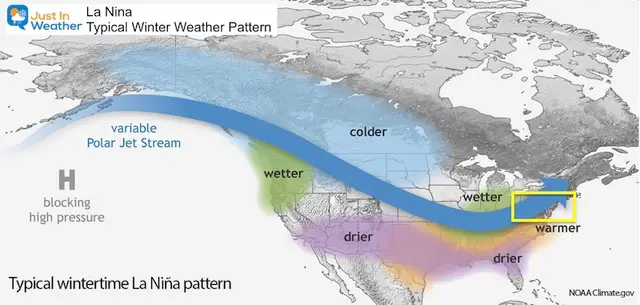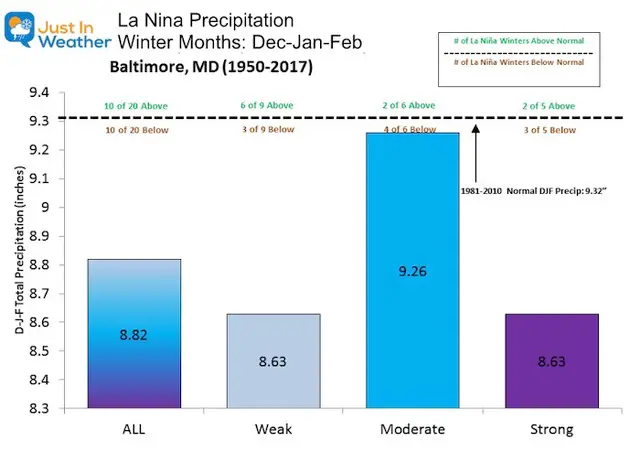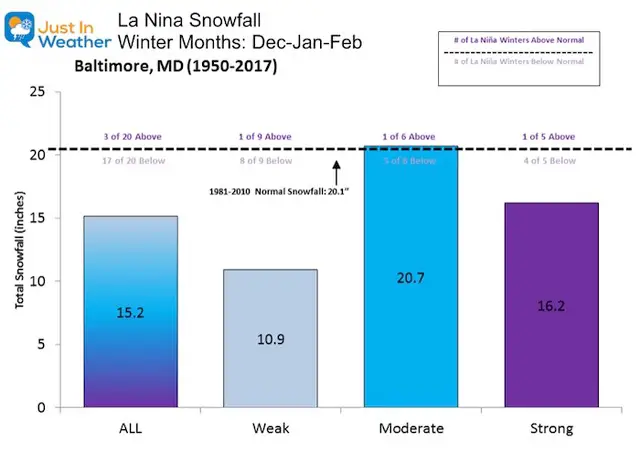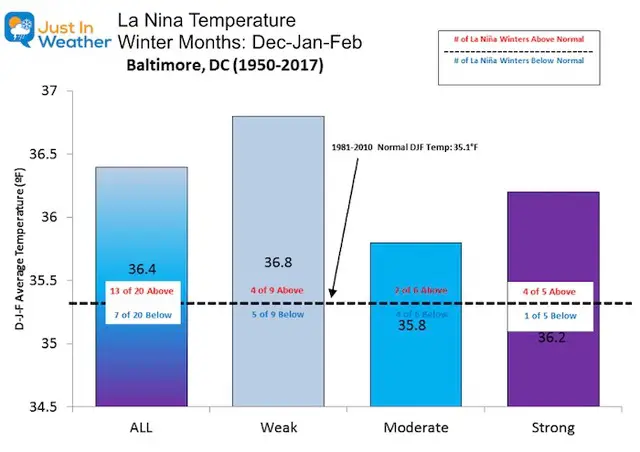La Nina Winters
La Niña Winter Weather Pattern

The storm track from the Pacific Ocean tends to take a northern route, diving across the central plains, then up the Ohio Valley.
I want to emphasize that this is the NOAA map for a ‘typical La Niña’ storm pattern. It is not static for the entire season.
I put the yellow box over the Mid Atlantic. We are in a region that can be on the edge of the storm track. There are other factors that can shift this south and colder for us, or west and warmer. It is possible to average a warm pattern, and still get a few strong cold storms.
La Niña Winter History: Baltimore
These state generated from the National Weather Service are not supportive of a snowy winter. The caveat is that this is only from 1950 to 2017. There are quality weather records back to 1882. But the La Niña years historically are more extrapolation, since that pattern was not thoroughly studied by scientists then.
However, within this data there are exceptions and other factors that may not have teamed up together before. I will continue to explore them for my formal outlook.
Important To Note:
La Niñas are not all the same. The intensity ‘weak’, ‘moderate’, and ‘strong’ can yield different results for our region.
Video: La Niña Explained
From NOAA’s National Ocean Service



Temperatures
Warmer than normal 65% of the La Niña Winters.
Cooler than normal 35% of La Niña Winters.
- Weak La Niña is even chances.
- Moderate La Niña is most likely to bring colder temperatures.
Precipitation
This is total precipitation for rain and snow.
Overall there is an even split. But this chart can be confusing. A Moderate La Niña has had 4 of 6 times been below average, but the chart has the largest total. This is because when there is an above average pattern, it can be WAY ABOVE AVERAGE to offset the total comparison.
Snowfall
If you have Faith in the Flakes, this might not be what you want to see. But there is a silver lining. While most years show below normal snow, there have been some big exceptions.
- 1996- January Blizzard was in a La Nina year. This also accounted for most of the snow that winter.
- 2000 – Most of snowfall that winter was in a 10 day period between January 20 and 30. This included the ‘surprise’ Nor’easter that brought 14.9″ of snow to BWI on January 25.
Take Away:
If you don’t want snow, La Niña historically has been your friend.
But if you have FITF, all is not lost. There have been years with big snow storms during a La Niña. Also, there are other elements at play. That is what I explore and try to fit together. This is not scientific law, only one theory. Correlation is NOT causation! It is possible that this winter may have a new combination of global influence to bring us something unprecedented. Besides, these numbers above are only a sample of 77 years. There may have been more supportive data in prior years.
Faith in the Flakes Gear
SNOWSTIX – Available Now
Please share your thoughts, best weather pics/video, or just keep in touch via social media
Facebook: Justin Berk, Meteorologist
Twitter: @JustinWeather
Instagram: justinweather





